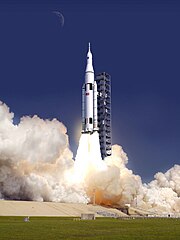NASA has a dilemma. It wants to take the next step in human space exploration. That step invloves leaving Low Earth Orbit and going to the Moon, Asteroids, and eventually Mars. The problem is that since the mid 1990's Congress has not been providing money to NASA to meet their ambitions. NASA has one of, if not 'the', premier manned space programs. With the economic situation in the world I don't see that changing. Let's look at what NASA is asking the Federal government to do and what an alternate solution can be.
 |
| Space Launch System |
NASA is making a new rocket. It's 'going to be' the biggest rocket ever built and flown, if it's appropriately funded. It's called the Space Launch System (
SLS). It is to launch large cargo or spacecraft to orbit. I stop short there and some people would say, "No, it's supposed to launch spacecraft beyond low earth orbit". Well, reality is that to get beyond low orbit, you need to get to low orbit and then have a booster with enough fuel to get you where you want to go. That is what I call a spacecraft. For example in the
Apollo Program, when the Saturn V rocket got the command module/service module, the lunar lander, and the
S-VIB booster made up the space craft that launched from low orbit to the moon. In the
LRO/
LCROSS launch, the Centaur booster was part of the spacecraft that launched from low orbit to the moon, even though the Centaur was also the second stage of the Atlas V rocket used to take the stack to low orbit. The maneuver from low orbit to the moon is called the translunar injection (
TLI). The SLS is projected to cost $18 billion to include the manned spacecraft called the
Multi-Purpose Crew Vehicle. Now NASA is looking for more money but this time to build a small
space station around the Moon called
Gateway. In 2006 an estimate cost of the International Space Station was at
$35 billion, and that was low balling it. A small space station around the moon or at a
lagrange point could cost just as much or close to it. The reason is that although smaller, it takes a lot of energy to get it out there. Will Congress support NASA with full funding in these efforts? Judging from the last decade, I say no. The effort will probably be a waste of time and money, just like other defunct NASA programs such as
Constellation.
 |
| Falcon 9 |
There is an alternate route that NASA can pursue. Leveraging commercial companies services to space and in space refueling, NASA can get in the business of human space exploration again. The
Augustine Commission Final Report found that cost of space exploration could be reduced by the use of commercial cargo launches to fuel manned spacecraft to go explore from low orbit and use mid lift rockets such as the
EELV and
Falcon 9. This would be an alternative to a large rocket operation such as the SLS which could launch both spacecraft and fuel at the same time. NASA has pursued a different way of operations with the ISS cargo and new crew with its
Commercial Crew and Cargo Office (C3PO) which lead to the
Commercial Space Transportation Program. It operated differently than usual at NASA. In it, NASA pays for transportation services rather than ownership. The commercial company owns and operates the launcher and spacecraft. This saves money for NASA because price is set and doesn't slip like in developing and operating rockets such as Apollo, Shuttle, and Constellation. This in turn allows the commercial company to make money from NASA and other customers allowing for creativity. An example of such creativity is SpaceX's
DragonLab in which SpaceX gets multiple science customers for one Dragon capsule flight. In a sense, SpaceX is continuing what Shuttle did for the science community. So the alternate process for a large launcher would require several launches from Earth to build a TLI spacecraft and fuel it in low orbit. This would then launch from low orbit and go off and do it's mission on Moon, Asteroid, or Mars. They could even build a small space station and send it to the moon using ion thrusters without people, only to be manned when its in its position in a Lagrange point or around the Moon itself. The launchers needed exist today. SpaceX is in the process of building a bigger launcher called
Falcon Heavy which could bring down the cost per launch of such efforts. I think the real key to success is to operate like NASA'a C3PO suggests and pay for services rather than own launchers.
NASA should get out of the business of making rockets, and get into the business of exploration, science, and aerospace research alone. It's time commercial companies take over launches. The United States won't financially support NASA's ambitions with business as usual.


